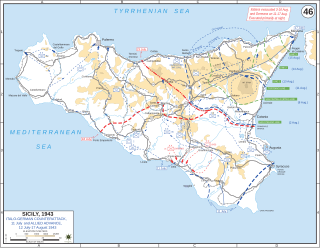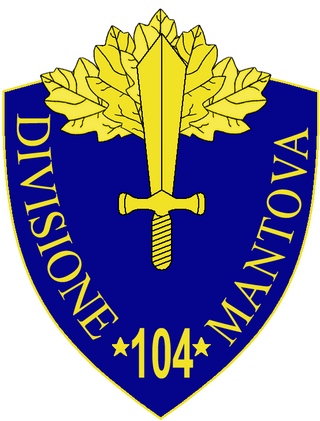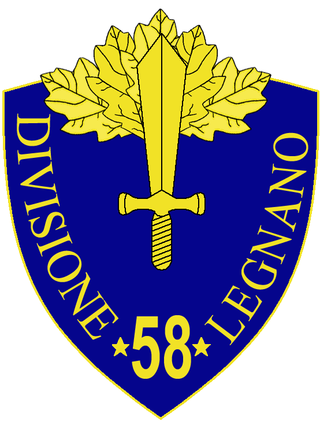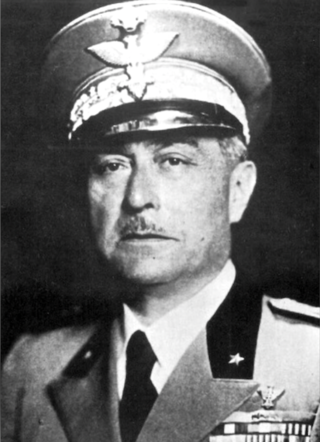Related Research Articles

The Allied invasion of Sicily, also known as the Battle of Sicily and Operation Husky, was a major campaign of World War II in which the Allied forces invaded the island of Sicily in July 1943 and took it from the Axis powers. It began with a large amphibious and airborne operation, followed by a six-week land campaign, and initiated the Italian campaign.

The 30th Infantry Division "Sabauda" was an infantry division of the Royal Italian Army during World War II. The Sabauda was based in Cagliari in Sardinia and named for the Latin name of the Royal House of Savoy. After the announcement of the Armistice of Cassibile on 8 September 1943 the division joined the Italian Co-belligerent Army.

The 7th Infantry Division "Lupi di Toscana" was an infantry division of the Royal Italian Army during World War II. The Division, with the exception of the 78th Infantry Regiment based in Bergamo, was based in Brescia. Despite its name referencing the region of Tuscany, the division was formed by men from Lombardy, especially from Brescia, Bergamo and the surrounding valleys.

The 104th Infantry Division "Mantova" was an infantry division of the Royal Italian Army during the Second World War. The Mantova was named for the city of Mantua and classified as an auto-transportable division, meaning it had some motorized transport, but not enough to move the entire division at once.

The 31st Infantry Division "Calabria" was an infantry division of the Royal Italian Army during World War II. The Calabria was formed in Sassari and named for the region of Calabria. The division was part of the garrison of Sardinia, where it remained until the Armistice of Cassibile, after which it served in the Italian Co-belligerent Army.
The 204th Coastal Division was an infantry division of the Royal Italian Army during World War II. Royal Italian Army coastal divisions were second line divisions formed with reservists and equipped with second rate materiel. Recruited locally, they were often commanded by officers called out of retirement.
The 211th Coastal Division was an infantry division of the Royal Italian Army during World War II. Royal Italian Army coastal divisions were second line divisions formed with reservists and equipped with second rate materiel. They were often commanded by officers called out of retirement.

The 44th Infantry Division "Cremona" was an infantry division of the Royal Italian Army during World War II. The Cremona was formed on 24 August 1939 by splitting the 20th Infantry Division "Curtatone and Montanara" into the 20th Infantry Division "Friuli" and 44th Infantry Division "Cremona". The division was named for the city of Cremona. The division served as occupation force on Corsica and fought German units after the Armistice of Cassibile was announced on 8 September 1943. The division then served with the Italian Co-belligerent Army and remained active until the 1975 Italian Army reform.
The 212th Coastal Division was an infantry division of the Royal Italian Army during World War II. Royal Italian Army coastal divisions were second line divisions formed with reservists and equipped with second rate materiel. They were often commanded by officers called out of retirement.
The 214th Coastal Division was an infantry division of the Royal Italian Army during World War II. Royal Italian Army coastal divisions were second line divisions formed with reservists and equipped with second rate materiel. They were often commanded by officers called out of retirement.
The 227th Coastal Division was an infantry division of the Royal Italian Army during World War II. Royal Italian Army coastal divisions were second line divisions formed with reservists and equipped with second rate materiel. They were often commanded by officers called out of retirement.

The 58th Infantry Division "Legnano" was an infantry division of the Royal Italian Army during World War II. The Legnano's predecessor division was formed on 8 February 1934 in Milan and named for the medieval Battle of Legnano. On 24 May 1939 the division split to form the 6th Infantry Division "Cuneo" and the 58th Infantry Division "Legnano". After the announcement of the Armistice of Cassibile the Legnano resisted the invading German forces. The division's staff and 67th Infantry Regiment "Legnano" were used to form the first unit of the Italian Co-belligerent Army, which fought on the allied side in the Italian campaign. On 17 February 1944 the division's last units joined other commands and the division was officially dissolved.
The XXVI Army Corps was an infantry corps of the Royal Italian Army during World War I, the Italian invasion of Albania, and the Greco-Italian War and the subsequent Italian occupation of Greece during World War II.

The 185th Paratroopers Reconnaissance Target Acquisition Regiment "Folgore" is an Italian Army special forces unit. The regiment is part of the Italian Army's infantry arm's Paracadutisti speciality and assigned to the Army Special Forces Command.

Mario Arisio was an Italian general who served in the Italo-Turkish War, World War I, the Second Italo-Ethiopian War and World War II.

Camillo Mercalli was an Italian general during World War II.
The VII Army Corps was a corps of the Royal Italian Army between 1877 and 1944.
The XIII Army Corps was a corps of the Royal Italian Army between 1915 and 1945.
The XXX Army Corps was a corps of the Royal Italian Army between 1915 and 1943. It was also known as Special Army Corps between November 1940 and June 1941.
The IX Army Corps was a corps of the Royal Italian Army between 1877 and 1944.